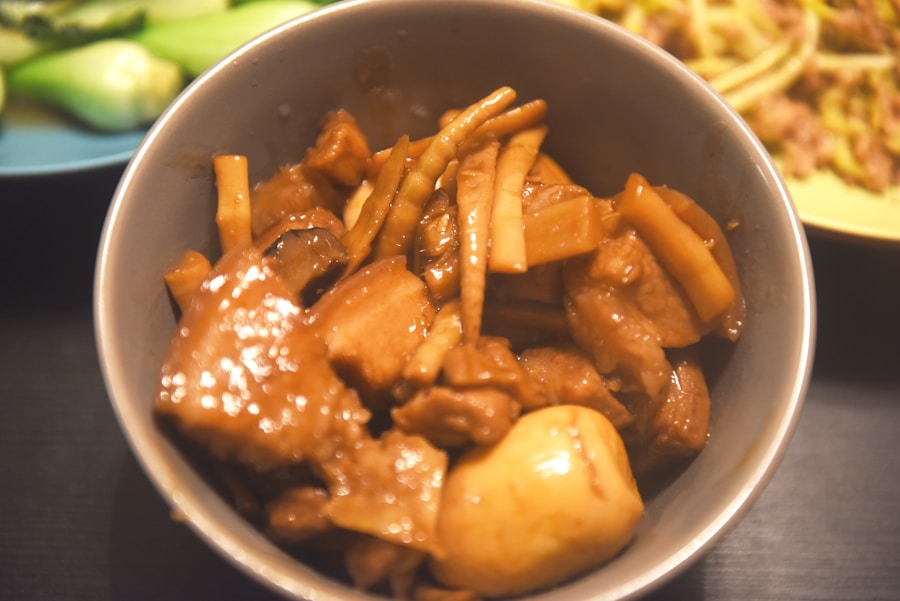The Ultimate Guide to Perfecting Adobo
Description
Adobo, a dish that has become synonymous with Filipino cuisine, boasts a rich and complex history that reflects the diverse cultural influences that have shaped the Philippines over centuries. The term “adobo” is derived from the Spanish word “adobar,” which means “to marinate.” This connection to Spanish colonialism is significant, as it was during the 16th century that the Spanish introduced their culinary practices to the archipelago. However, the roots of adobo extend far beyond this colonial influence, as indigenous cooking methods and local ingredients played a crucial role in its evolution.
Before the arrival of the Spanish, Filipinos were already adept at preserving food through various methods, including fermentation and drying. The use of vinegar, soy sauce, garlic, and spices in cooking was prevalent among indigenous communities. When the Spanish colonizers arrived, they encountered these traditional practices and began to incorporate their own techniques and ingredients.
The result was a fusion of flavors and methods that gave birth to the adobo we know today. Over time, regional variations emerged, each reflecting local tastes and available ingredients, leading to a dish that is both versatile and deeply rooted in Filipino culture.
Key Takeaways
- Adobo has a long history in Filipino cuisine, with its roots in the Spanish colonial era and influences from indigenous cooking techniques.
- The key ingredients in traditional adobo are vinegar, soy sauce, garlic, and bay leaves, but there are many regional variations that include different meats and additional spices.
- Marinating adobo for at least 30 minutes and cooking it low and slow allows the flavors to fully develop and the meat to become tender.
- Adobo pairs well with steamed rice, pickled vegetables, and fresh herbs, but can also be served with a variety of side dishes to complement its savory and tangy flavors.
- To make adobo healthier, consider using lean cuts of meat, reducing the amount of soy sauce and salt, and adding more vegetables to the dish. Additionally, using brown rice instead of white rice can increase the nutritional value of the meal.
Ingredients and Variations of Adobo
The Core Ingredients
At its core, adobo is characterized by its use of meat—commonly chicken or pork—marinated in a mixture of vinegar, soy sauce, garlic, bay leaves, and black peppercorns. This combination not only imparts a distinctive flavor but also acts as a preservative, allowing the dish to be stored for longer periods.
Variations Across Regions
Regional variations of adobo are abundant, each with its unique twist on the classic recipe. For instance, in the Ilocos region, adobo is often prepared with a more pronounced vinegar flavor and may include additional ingredients like sugar or potatoes. In contrast, the adobo from Batangas is known for its use of coconut milk, which adds a creamy richness to the dish.
Incorporating Local Flavors and Ingredients
Furthermore, some variations incorporate fruits such as pineapple or mango for a sweet contrast to the savory elements. These regional differences highlight not only the creativity of Filipino cooks but also the importance of local ingredients in shaping culinary traditions.
Tips for Marinating and Cooking Adobo

Marinating is a crucial step in preparing adobo, as it allows the flavors to penetrate the meat deeply. A good marinade typically consists of equal parts vinegar and soy sauce, along with crushed garlic and whole peppercorns. For optimal results, it is advisable to marinate the meat for at least an hour, although overnight marination can yield even more flavorful results.
The acidity of the vinegar helps tenderize the meat while infusing it with flavor. It is essential to balance the marinade’s acidity with saltiness; thus, adjusting the soy sauce according to personal taste is recommended. When it comes to cooking adobo, there are various methods to achieve that perfect balance of tenderness and flavor. Traditionally, adobo is simmered on the stovetop until the meat is cooked through and tender.
This method allows for the reduction of the marinade into a rich sauce that clings to the meat. Some cooks prefer to sear the meat first to develop a deeper flavor before adding the marinade. Alternatively, slow cooking or using a pressure cooker can also yield excellent results, especially for tougher cuts of meat.
Regardless of the method chosen, patience is key; allowing the dish to simmer gently will enhance its flavors and create a satisfying meal.
Pairing Adobo with Side Dishes
| Side Dish | Popularity | Rating |
|---|---|---|
| Garlic Rice | High | 4.5/5 |
| Steamed Vegetables | Medium | 4/5 |
| Grilled Eggplant | Low | 3.5/5 |
| Green Salad | Medium | 4/5 |
Adobo’s robust flavors make it an excellent centerpiece for a variety of side dishes that complement its savory profile. One of the most traditional accompaniments is steamed white rice, which serves as a neutral base that absorbs the rich sauce of the adobo. The simplicity of rice allows the complex flavors of the dish to shine through without overwhelming the palate.
In many Filipino households, adobo is often served with garlic fried rice (sinangag), which adds an aromatic element that enhances the overall dining experience. In addition to rice, other side dishes can elevate an adobo meal. For instance, pickled vegetables (achara) provide a refreshing contrast to the richness of adobo.
The acidity from pickling balances out the savory notes and adds a crunchy texture that complements the tender meat. Another popular pairing is sautéed greens or vegetables such as bok choy or string beans, which add color and nutrition to the plate.
Making Adobo Healthier
While adobo is undeniably delicious, it can also be made healthier without sacrificing flavor. One approach is to reduce the amount of oil used in cooking; instead of frying or sautéing the meat in oil before simmering it in the marinade, consider using non-stick cookware or simply adding a splash of water to prevent sticking. This method significantly cuts down on fat content while still allowing for a flavorful dish.
Another way to make adobo healthier is by incorporating more vegetables into the recipe. Adding ingredients like bell peppers, carrots, or even leafy greens not only boosts nutritional value but also adds texture and color to the dish.
By being mindful of ingredient choices and cooking methods, it is possible to enjoy this beloved dish while adhering to healthier eating habits.
Serving and Presentation Tips for Adobo

Presentation plays an essential role in enhancing the dining experience when serving adobo. A well-plated dish can elevate even the simplest meals into something special. To serve adobo attractively, consider using a large serving platter that allows for ample space for both the meat and sauce.
Garnishing with fresh herbs such as cilantro or green onions can add a pop of color and freshness that contrasts beautifully with the rich hues of the adobo. When serving adobo at gatherings or family meals, consider offering it alongside an array of side dishes arranged artfully on the table. This not only encourages sharing but also creates an inviting atmosphere where guests can explore different flavors and textures.
Providing small bowls for rice or side dishes allows diners to customize their plates according to their preferences. Additionally, using traditional Filipino serving ware can enhance authenticity; bamboo plates or woven baskets can add an element of cultural heritage that enriches the overall dining experience. In conclusion, adobo is more than just a dish; it is a reflection of Filipino culture and history that has evolved over time through various influences and regional adaptations.
Its versatility in ingredients and preparation methods makes it a beloved staple in many households while offering opportunities for creativity in both cooking and presentation. Whether enjoyed in its traditional form or adapted for modern tastes, adobo remains a cherished culinary treasure that continues to bring people together around the table.
FAQs
What is Adobo?
Adobo is a popular Filipino dish that involves marinating meat, seafood, or vegetables in a mixture of vinegar, soy sauce, garlic, and other seasonings, and then simmering it until tender.
What are the main ingredients in Adobo?
The main ingredients in Adobo typically include vinegar, soy sauce, garlic, bay leaves, and black peppercorns. The dish can be made with various proteins such as chicken, pork, beef, or seafood.
How is Adobo cooked?
Adobo is typically cooked by marinating the protein in the vinegar and soy sauce mixture for a few hours or overnight, and then simmering it in the marinade until the meat is tender. It is often served with rice.
Is Adobo spicy?
Adobo can be made spicy by adding chili peppers or hot sauce to the marinade. However, the traditional recipe is not inherently spicy.
What is the origin of Adobo?
Adobo is a traditional Filipino dish that has its roots in Spanish cuisine. The cooking method of marinating and stewing meat in vinegar and spices was introduced by the Spanish during their colonization of the Philippines.





